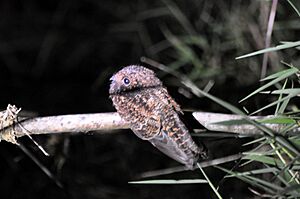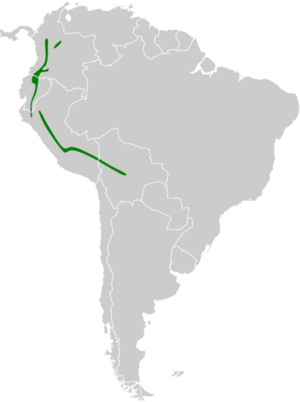Swallow-tailed nightjar facts for kids
Quick facts for kids Swallow-tailed nightjar |
|
|---|---|
 |
|
| Conservation status | |
| Scientific classification | |
| Genus: |
Uropsalis
|
| Species: |
segmentata
|
 |
|
The swallow-tailed nightjar (Uropsalis segmentata) is a fascinating bird known for its long tail. It belongs to a group of birds called nightjars, which are mostly active at night. You can find this bird in South American countries like Bolivia, Colombia, Ecuador, and Peru.
Contents
About This Bird
Family Tree
The swallow-tailed nightjar is related to the lyre-tailed nightjar. Both birds are part of the same group, called Uropsalis.
There are two main types, or subspecies, of the swallow-tailed nightjar:
- The first is called U. s. segmentata.
- The second is called U. s. kalinowskii.
Scientists first described the U. s. segmentata type as Hydropsalis segmentata. The U. s. kalinowskii type was once thought to be a completely different species.
What Does It Look Like?
The male swallow-tailed nightjar is famous for its super long outer tail feathers. These feathers are why it's called "swallow-tailed"! The female's tail is much shorter.
- A male bird, including its long tail, can be about 66 centimetres (26 inches) long. It weighs around 42 grams (1.5 ounces).
- A female bird is about 23 centimetres (9.1 inches) long. It weighs about 43 grams (1.5 ounces).
Both male and female birds have dark brown feathers on their upper bodies. These feathers have many tawny (light brownish-orange) spots. Their tails are mostly brown. The outer tail feathers of both sexes have white parts. Other tail feathers have tawny bars and spots. Their wings are brown or grayish-brown with tawny spots.
The chin and throat are dark brown with buff (pale yellowish-brown) spots. The chest is dark brown with tawny and buff patterns. The belly and sides are buff with brown bars.
The U. s. kalinowskii subspecies has a slightly shorter tail. The white on its outer tail feathers is in bars, not one continuous line. Its inner tail feathers have a whitish band near the tip.
Where Does It Live?
The swallow-tailed nightjar lives in the Andes Mountains in South America.
- The U. s. segmentata subspecies lives in Colombia and Ecuador.
- The U. s. kalinowskii subspecies lives in Peru and Bolivia.
In Colombia, you can find it in the Central and Eastern Andes mountains. In Ecuador, it lives on the western and eastern slopes of the main Andes. It also lives along most of Peru and into Bolivia.
These birds live at high elevations:
- In Colombia, from 2,500 to 3,500 metres (8,200 to 11,500 feet) high.
- In Peru, from 2,000 to 3,600 metres (6,600 to 11,800 feet) high.
- In Bolivia, from 2,000 to 3,400 metres (6,600 to 11,200 feet) high.
- In Ecuador, mostly from 2,500 to 3,200 metres (8,200 to 10,500 feet) high, but sometimes as low as 2,100 metres (6,900 feet).
The swallow-tailed nightjar usually lives in elfin forests. These are forests with small, twisted trees. It also likes the edges of wet montane forests and open areas with bamboo, grass, or bushes.
Bird Behavior
What Do They Eat?
The swallow-tailed nightjar is active during dawn and dusk and at night. It hunts for insects by flying out from the ground or a low branch. It also hunts while flying low over open areas. We don't know all the details of its diet, but it definitely eats insects! During the day, it rests on the ground.
Reproduction
We don't know exactly when the swallow-tailed nightjar's breeding season is. However, it seems to include August and September.
Only one nest has been studied closely. It was a small dip in the ground. It was lined with dried leaves and dead twigs. This nest held one egg. This is different from many other nightjars, which often lay their eggs right on the bare ground.
What Do They Sound Like?
The song of the swallow-tailed nightjar is very special and beautiful. It sounds like a vibrating "worr-r-r-e-e-e-e-e-r". The sound starts by going up, then drops down. The bird sings this song from the ground.
It also makes other sounds:
- A liquid, rising "pwip".
- A musical, soft, stuttered whistle when it feels worried or upset.
Conservation Status
The IUCN (International Union for Conservation of Nature) has looked at the swallow-tailed nightjar. They have decided it is a species of "Least Concern". This means it is not currently in danger of disappearing.
We don't know the exact number of these birds, but scientists believe their population is stable. No immediate threats have been found. However, cutting down forests (deforestation) could become a problem for them in the future.


